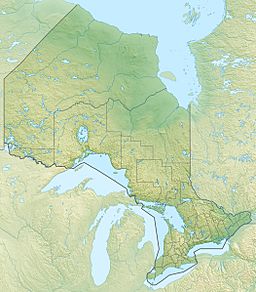Black Lake (Marchington River) facts for kids
Quick facts for kids Black Lake |
|
|---|---|
| lac Black | |
| Location | Kenora District, Ontario |
| Coordinates | 50°08′35″N 91°36′00″W / 50.14306°N 91.60000°W |
| Part of | Hudson Bay drainage basin |
| Primary outflows | Unnamed creek to Botsford Lake |
| Basin countries | Canada |
| Max. length | 2.0 kilometres (1.2 mi) |
| Max. width | 0.6 kilometres (0.4 mi) |
| Surface elevation | 372 metres (1,220 ft) |
Black Lake is a lake located in the Kenora District of Ontario, Canada. It is also known by its French name, lac Black. This lake is part of a very large system of rivers and lakes called the Hudson Bay drainage basin. This means its water eventually flows all the way to Hudson Bay.
The lake is about 2 kilometers (1.2 miles) long and 0.6 kilometers (0.4 miles) wide. It sits at an elevation of 372 meters (1,220 feet) above sea level.
Where is Black Lake?
Black Lake is found in the northwestern part of Ontario. It's located in an area known as the Unorganized Part of Kenora District. This means there aren't any official towns or cities right on its shores.
The lake is about 13 kilometers (8 miles) northeast of a place called Superior Junction. It's also about 4 kilometers (2.5 miles) southwest of McDougall Mills. Another spot, Rosnel, is about 1.3 kilometers (0.8 miles) north of the lake.
Water Flow and Connections
The main way water leaves Black Lake is through an unnamed creek. This creek flows north into Botsford Lake. From Botsford Lake, the water joins the Marchington River.
The Marchington River then flows into the English River. After that, the water travels through the Winnipeg River and finally reaches the Nelson River. The Nelson River is a major river that empties into Hudson Bay. This whole journey shows how Black Lake is connected to a vast network of waterways.
Interestingly, the CN transcontinental rail line crosses the creek that connects Black Lake to Botsford Lake. This railway is a very important transportation route across Canada.


